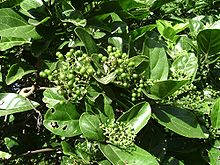| Premna serratifolia | |
|---|---|

| |
| Leaves and young fruit | |
| Scientific classification | |
| Kingdom: | Plantae |
| Clade: | Tracheophytes |
| Clade: | Angiosperms |
| Clade: | Eudicots |
| Clade: | Asterids |
| Order: | Lamiales |
| Family: | Lamiaceae |
| Genus: | Premna |
| Species: | P. serratifolia
|
| Binomial name | |
| Premna serratifolia | |
| Synonyms | |
Premna serratifolia is a small tree/shrub[2] in the family Lamiaceae. It flowers and fruits between May and November.[3] During flowering season, it attracts a large number of butterflies and bees.[4] Synonyms of Premna serratifolia Linn. include P. corymbosa (Burm. f.) Merr., P. integrifolia L. and P. obtusifolia R. Br.).
Habitat[edit]
It mostly grow in moist sandy soil and scrub jungles along seacoasts and mangrove forests.[3] In the Philippines, particularly in Cebu Island, it is usually found in the interior, watery forests of Southern Cebu.
Description[edit]
Trees, to 7 m high. Leaves simple, opposite, estipulate; petiole 4–14 mm, slender, pubescent, grooved above; lamina 2.5-8.5 x 2–7.2 cm, elliptic, elliptic-oblong, base acute, obtuse, subcordate or rounded, apex acuminate, mucronate, obtuse, margin entire or subserrate, glabrous above except along the appressed midrib, chartaceous; lateral nerves 3-5 pair, pinnate, prominent, puberulous beneath; intercostae reticulate, obscure. Flowers bisexual, greenish-white, in terminal corymbose panicled cymes; bracts small; calyx small campanulate, 2 lipped, 5 lobed; corolla tube short, villous inside, lobes 5; stamens 4, didynamous, inserted below the throat of the corolla tube; anther ovate; ovary superior, 2-4-celled, ovules 4; style linear; stigma shortly bifid. Fruit a drupe, seated on the calyx, globose, purple; seeds oblong.[3]
Medicinal uses[edit]
The plant is extensively used in Indian traditional medicine. Studies on the root wood of P. serattifolia led to the isolation of acteoside, a glucoside derivative.[5] The root bark of the plant which showed biological activities have also shown to contain a potent cytotoxic and antioxidant diterpene, 11,12,16-trihydroxy-2-oxo-5-methyl-10-demethyl-abieta-1[10],6, 8,11,13-pentene.[6]
Culinary uses[edit]
In Vietnam, the aromatic leaves of P. serratifolia are called lá cách, and are used to cook in some braise or stir fry dishes with chicken, eels or frogs.[citation needed]
References[edit]
- ^ Razafiniary, V. (2021). "Premna serratifolia". IUCN Red List of Threatened Species. 2021: e.T66295794A68121996. doi:10.2305/IUCN.UK.2021-1.RLTS.T66295794A68121996.en. Retrieved 20 November 2021.
- ^ Description given by G. Renu, Sanjana Julias Thilakar, D. Narasimhan, Centre for Floristic Research, Department of Botany, Madras Christian College, Tambaram. Referred from indiabiodiversity portal http://indiabiodiversity.org/species/show/230814
- ^ a b c Described by Dr. N Sasidharan (Dr. B P Pal Fellow), Kerala Forest Research Institute, Peechi in India biodiversity portal http://indiabiodiversity.org/species/show/230814
- ^ The media files included gives the required verity.
- ^ Bose LV, Varghese GK, Habtemariam S. 2013. Identification of acteoside as the active antioxidant principle of Premna serratifolia root wood tissues. Phytopharmacology 4: 228–236
- ^ Habtemariam, S., Varghese, G.K. (2015). A Novel Diterpene Skeleton: Identification of a highly aromatic, cytotoxic and antioxidant 5-methyl-10-demethyl-abietane-typediterpene from Premna serratifolia Phytotherapy Research 29(1), 80-85.
Further reading[edit]
- Flora of Tamil Nadu, VOL. II, 1987
- Premna serratifolia L., Mant. Pl. 2: 253. 1771; Gamble, Fl. Pres. Madras 1096(767). 1924; Ramach. & V.J. Nair, Fl. Cannanore Dist. 357. 1988; Antony, Syst. Stud. Fl. Kottayam Dist. 318. 1989; Rajendran & Daniel, Indian Verbenaceae 284. 2002.
- Premna integrifolia L., Mant. Pl. 2: 252. 1771, nom. illeg.; Hook. f., Fl. Brit. India 4: 574. 1885.
- Premna obtusifolia R. Br., Prodr. 512. 1810; Manilal & Sivar., Fl. Calicut 230. 1982; Ansari, Fl. Kasaragod Div. 296. 1985
